Sun-Maid
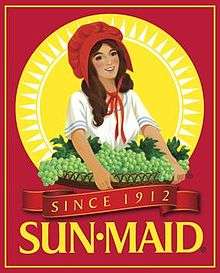 | |
| agricultural marketing cooperative | |
| Predecessor | California Associated Raisin Company |
| Founded | 1912 |
| Headquarters | Kingsburg, California, United States |
Area served | California |
| Products | Raisins and Dried Fruit |
| Website |
www |
Sun-Maid Growers of California is a privately owned American cooperative of raisin growers headquartered in Kingsburg, California. Sun-Maid is the largest raisin and dried fruit processor in the world. As a cooperative, Sun-Maid is made up of approximately 850 family farmers who grow raisin grapes within 100 miles (200 km) radius of the processing plant. Sun-Maid also sources dried fruit beyond this geographical area. In 2012, Sun-Maid celebrated its 100th anniversary as a grower cooperative.
Sun-Maid raisins are packaged in a red box featuring the iconic “Sun-Maid Girl” wearing a red sunbonnet and holding a tray of fresh grapes. Sun-Maid raisins are grown in the Central Valley of California, midway between Los Angeles and San Francisco, a region known for its unique Mediterranean climate perfect for growing grapes and drying them to make raisins. The grapes are picked at harvest time, usually late August to early September, and dried naturally in the sun, either by hand-picking them and laying them on paper trays or allowing them to dry-on-the-vine (DOV) for mechanical harvesting. After about 14 days, they are placed in bins and delivered to the Sun-Maid plant for processing, packaging and shipping to customers throughout the United States and in more than 60 countries around the world.
Sun-Maid produces more than 200 million pounds of natural raisins annually. Nearly half of all Sun-Maid raisins are packed for consumer sales, whether in a box, a bag or a canister in varying sizes. The other half are sold as an ingredient to bakeries, cereal companies, as raisin paste and raisin concentrate. The Thompson Seedless grape is the most popular variety used to make raisins, although other grapes, such as Fiesta, Flame and Zante currants are also used.
In addition to raisins, Sun-Maid packs a full line of dried fruit, such as figs, dates, cranberries, apples, prunes, apricots and tropical fruits. Sun-Maid also packs yogurt-covered raisins, such as those dipped in dark chocolate, vanilla, orange cream, strawberry-Greek and cherry-chocolate flavored yogurt.
The company maintains extensive brand licensing and food service operations. The Promotion in Motion Companies, Inc., under license from Sun-Maid, produces a Sun-Maid Milk Chocolate Covered Raisin.
History
In 1873, Francis T. Eisen planted an experimental vineyard of Muscat grapes on 25 acres along Fancher Creek, just east of Fresno. In his 1891 publication, California Homes and Industries, Eisen described the first production year in 1877: “It was a very hot year, and before the Muscat grapes were harvested a quantity of the crop dried on the vines, and we treated them as raisins, stemmed them, put them in boxes, and sent them to San Francisco market. They were sold to fancy grocers, who exposed them in show-windows and reported them imported from Peru; but a Mr. Hickson found they were from the Eisen Vineyard, and went there to see, and informed raisin dealers that the best raisins were made in Fresno County. Others then entered into the business, and this was the foundation for the present reputation of Fresno for raisins.”
Packaged raisins were shipped out of the state by 1878, and by 1903, California was producing 120 million pounds of raisins a year.
Packing and Shipping
Packing houses quickly became a vital link between the grower and the consumer, and dozens sprouted up across the San Joaquin Valley. Employing hundreds of people, these facilities received the sun-dried raisins from the grower; then they stored, processed, packaged, and shipped the fruit throughout the United States and to countries around the world. When the transcontinental railroad was completed in 1869, farmers and immigrants from the East settled the area and for the first time, growers were able to quickly transport products from the West to new markets. In 1872, Leland Stanford brought the Central Pacific Railroad to the San Joaquin Valley, choosing a location in present-day downtown Fresno as the rail stop, Fresno Station. Depots in surrounding communities soon followed. As the railroads expanded, so too did the area surrounding Fresno Station, attracting farmers eager to grow agricultural products to satisfy the increasing demand from faraway markets.
California Associated Raisin Company Formed
Once raisins were established as a marketable crop which grew and dried well under the Californian sun, raisin grape-growing areas expanded rapidly in the late 19th century. The earliest successful efforts to form a cooperative business by raisin growers began in 1898. With community support, the California Associated Raisin Company was established in 1912. In 1915, the brand name Sun-Maid, coined by advertising executive E.A. Berg, was launched; and in 1918 the company opened a new facility near downtown Fresno, California, which was recognized at the time as the "finest factory building west of Detroit."

By the early 1920s, the California Associated Raisin Company’s membership comprised 85 percent of the state’s raisin growers. The organization changed its name to Sun-Maid Growers of California in 1922 to identify more closely with its nationally recognized brand.
In 1964, further modernization and growth led to the construction of, and move to, a new facility in neighboring Kingsburg, which was voted one of America’s top new plants by Factory magazine that year. The 640,000-square-foot, state-of-the-art facility sits on more than 100 acres, 20 miles south of Fresno. To this day, the Kingsburg plant serves as the international headquarters of Sun-Maid Growers of California. People from all over the world enjoy visiting the Sun-Maid Headquarters, featuring the world’s largest box of raisins, a larger-than-life image of the Sun-Maid Girl and The Sun-Maid Market, a grower’s store filled with a variety of Sun-Maid products.
Sun-Maid Girl
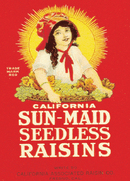
The original "Sun-Maid Girl" was a real person named Lorraine Collett. She attended the 1915 Panama–Pacific International Exposition in San Francisco as one of several young girls representing the California Associated Raisin Company. The Sun-Maid girls promoted the raisin industry by handing out raisin samples to visitors of the Expo while wearing white blouses with blue piping and blue sunbonnets.
As Collett would later tell, "It was only after we returned to Fresno that I was seen by Sun-Maid executive Leroy Payne wearing my mother’s red bonnet in my backyard that the bonnet color was changed from blue to red, because red reflected the color of the sun better."
A photograph of Collett appeared in the San Francisco Bulletin in 1915 and promoted Sun-Maid’s activities at the Exposition. While working at the Expo in San Francisco, Collett posed at the Post Street studio of artist Fanny Scafford in the morning, and then spent the rest of the day working the Expo, where the Sun-Maid girls were by then all wearing red bonnets. The artist experimented with a variety of positions and props, finally settling on the iconic pose with an overflowing tray of grapes and a glowing sunburst in the background.
In May 1916, company executives agreed Collett would become the personification of the company. Her image with sunbonnet and tray of grapes was updated in 1956 and again in 1970, using drawings made a decade earlier of company employee Delia von Meyer (Pacheco).[1]
After the Exposition, Collett did further modeling and appeared in the 1916 Cecil B. DeMille film Trail of the Lonesome Pine. Lorraine Collett Petersen, as she was known after marrying, later became a nurse and until her death at the age of 90, continued to make special appearances as the original Sun-Maid Girl.
The current version was created in 1970 by John Lichtenwalner, a freelance commercial artist in San Francisco. Lichtenwalner, a graduate of Art Center in Los Angeles, used the previous versions of the Sun-Maid Girl to create a cleaner version of the character. The model for the updated portrait was a young actress/model, Liz Weide. The portrait was centered over a figurative sunburst. The artwork, sold as piecework to the Sun-Maid Raisin Co., has been reproduced internationally and is perhaps the artist's best known work, unchanged for more than 40 years. Lichtenwalner is a former president of the San Francisco Illustrator's Society.[2]
In 2006, the Sun-Maid Girl was animated for television commercials in which she walked and talked for the first time. The commercials were designed and produced by Synthespian Studios.
Evolution of the brand
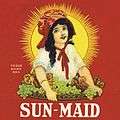 The California Associated Raisin Company begins using the “Sun-Maid” brand name and the painting of Lorraine Collett.
The California Associated Raisin Company begins using the “Sun-Maid” brand name and the painting of Lorraine Collett.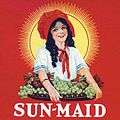 The original image of the Sun-Maid Girl is modified for the first time, giving her a bigger smile, brighter colors, and a stylized sun. This contemporary look was in style with the 1920s.
The original image of the Sun-Maid Girl is modified for the first time, giving her a bigger smile, brighter colors, and a stylized sun. This contemporary look was in style with the 1920s.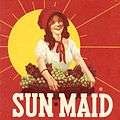 The trademark is updated for the second time. The sun was moved off-center, intensifying the effect of the sunshine with the bonnet casting a shadow across the Sun-Maid Girl’s face.
The trademark is updated for the second time. The sun was moved off-center, intensifying the effect of the sunshine with the bonnet casting a shadow across the Sun-Maid Girl’s face.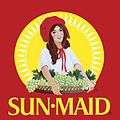 Brighter colors and a geometric sun modernizes the logo, with the brand’s name now printed in yellow, for a warmer, sunnier feel. This Sun-Maid Girl continues on packaging into the 21st century.
Brighter colors and a geometric sun modernizes the logo, with the brand’s name now printed in yellow, for a warmer, sunnier feel. This Sun-Maid Girl continues on packaging into the 21st century.
References
- ↑ The Sun-Maid Girl
- ↑ personal communication, John Lichtenwalner